Etruscan Civilization › Roman Literature » Ancient origins
Articles and Definitions › Contents
- Etruscan Civilization › Ancient History
- Roman Literature › Antique Origins
Ancient civilizations › Historical and archaeological sites
Etruscan Civilization › Ancient History
Definition and Origins
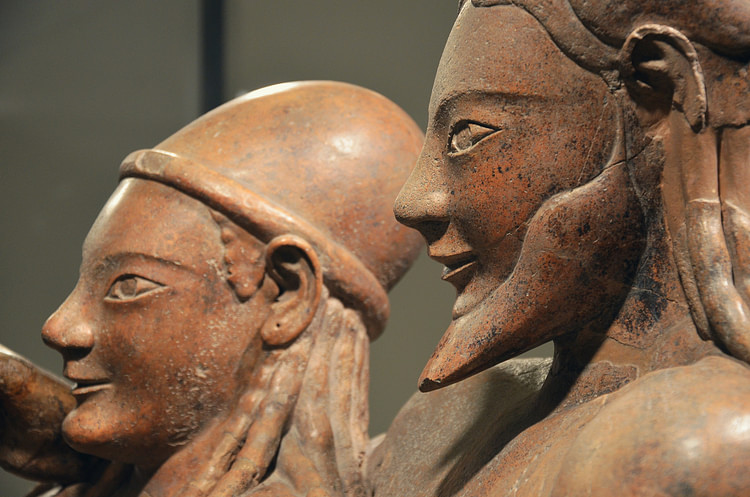
The Etruscan civilization flourished in central Italy between the 8th and 3rd century BCE. The culture was renowned in antiquity for its rich mineral resources and as a major Mediterranean trading power. Much of its culture and even history was either obliterated or assimilated into that of its conqueror, Rome. Nevertheless, surviving Etruscan tombs, their contents and their wall paintings, as well as the Roman adoption of certain Etruscan clothing, religious practices, and architecture, are convincing testament to the great prosperity and significant contribution to Mediterranean culture achieved by Italy's first great civilization.
VILLANOVAN CULTURE
The Villanovan culture developed during the Iron Age in central Italy from around 1100 BCE. The name is actually misleading as the culture is, in fact, the Etruscans in their early form. There is no evidence of migration or warfare to suggest the two peoples were different. The Villanovan culture benefitted from a greater exploitation of the area's natural resources, which allowed villages to form. Houses were typically circular and made of wattle and daub walls and thatch roofs with wooden and terracotta decoration added; pottery models survive which were used to store the ashes of the deceased. With the guarantee of regular, well-managed crops a portion of the community was able to devote itself to manufacturing and trade. The importance of horses is seen in the many finds of bronze horse bits in the large Villanovan cemeteries located just outside their settlements. By around 750 BCE the Villanovan culture had become the Etruscan culture proper, and many of the Villanovan sites would continue to develop as major Etruscan cities. The Etruscans were now ready to establish themselves as one of the most successful population groups in the ancient Mediterranean.
THE ETRUSCAN CITIES WERE INDEPENDENT CITY -STATES LINKED TO EACH OTHER ONLY BY A COMMON RELIGION, LANGUAGE & CULTURE IN GENERAL.
ETRURIA
The Etruscan cities were independent city-states linked to each other only by a common religion, language, and culture in general. Geographically spread from the Tiber River in the south to parts of the Po Valley in the north, the major Etruscan cities included Cerveteri (Cisra), Chiusi (Clevsin), Populonia (Puplona), Tarquinia (Tarchuna), Veii (Vei), Vetulonia (Vetluna), and Vulci (Velch). Cities developed independently so that innovations in such areas as manufacturing, art and architecture, and government occurred at different times in different places. Generally speaking, coastal sites, with their greater contact with contemporary cultures, evolved quicker but eventually passed on new ideas to the Etrurian hinterland. Nevertheless, the Etruscan cities still developed along their own lines, and significant differences are evident in one city from another.
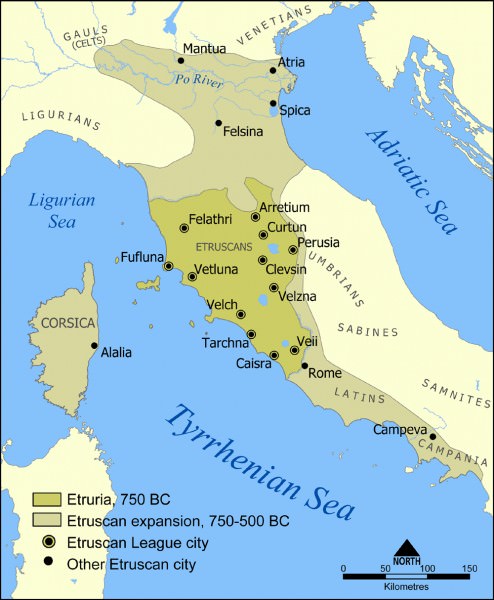
Etruscan Civilization
Prosperity was based on fertile lands and improved agricultural tools to better exploit it; rich local mineral resources, especially iron; the manufacture of metal tools, pottery, and goods in precious materials such as gold and silver ; and a trade network which connected the Etruscan cities to each other, to tribes in the north of Italy and across the Alps, and to other maritime trading nations such as the Phoenicians, Greeks, Carthaginians, and the Near East in general. Whilst slaves, raw materials, and manufactured goods (especially Greek pottery ) were imported, the Etruscans exported iron, their own indigenous bucchero pottery, and foodstuffs, notably wine, olive oil, grain, and pine nuts.
HISTORICAL OVERVIEW
With trade flourishing from the 7th century BCE, the cultural impact of the consequent increase in contact between cultures also became more profound. Craftsmen from Greece and the Levant settled in emporia – semi-independent trading ports that sprang up on the Tyrrhenian coast, most famously at Pyrgri, one of the ports of Cerveteri. Eating habits, clothing, the alphabet, and religion are just some of the areas where Greek and Near Eastern peoples would transform Etruscan culture in the so-called 'Orientalising' period.
Etruscan cities teamed with Carthage to successfully defend their trade interests against a Greek naval fleet at the Battle of Alalia (aka Battle of the Sardinian Sea) in 540 BCE. Such was the Etruscan dominance of the seas and maritime trade along the Italian coast that the Greeks repeatedly referred to them as scoundrel pirates. In the 5th century BCE, though, Syracusewas the dominant Mediterranean trading power, and the Sicilian city combined with Cumae to inflict a naval defeat on the Etruscans at the battle at Cumae in 474 BCE. Worse was to come when the Syracusan tyrant Dionysius I decided to attack the Etruscan coast in 384 BCE and destroy many of the Etruscan ports. These factors contributed significantly to the loss of trade and consequent decline of many Etruscan cities seen from the 4th to 3rd century BCE.
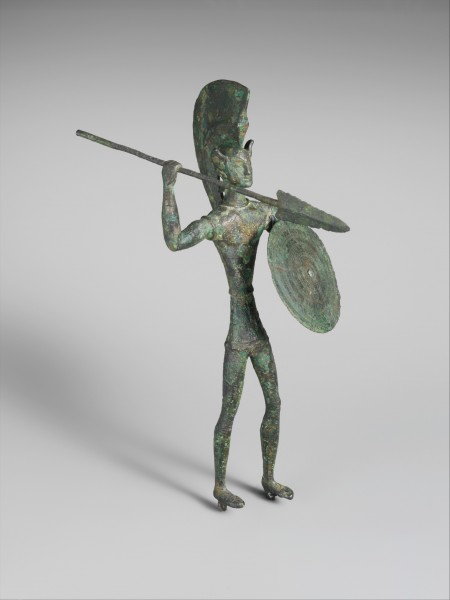
Etruscan Bronze Warrior
Inland, Etruscan warfare seems to have initially followed Greek principles and the use of hoplites – wearing a bronze breastplate, Corinthian helmet, greaves for the legs, and a large circular shield – deployed in the static phalanx formation, but from the 6th century BCE, the greater number of smaller round bronze helmets would suggest a more mobile warfare.Although several chariots have been discovered in Etruscan tombs, it is likely that these were for ceremonial use only. The minting of coinage from the 5th century BCE suggests that mercenaries were used in warfare, as they were in many contemporary cultures. In the same century, many towns built extensive fortification walls with towers and gates. All of these developments point to a new military threat, and it would come from the south where a great empire was about to be built, starting with the conquest of the Etruscans. Rome was on the warpath.
FROM THE 6TH CENTURY BCE, THE GREATER NUMBER OF SMALLER ROUND BRONZE HELMETS WOULD SUGGEST A MORE MOBILE WARFARE.
In the 6th century BCE some of Rome's early kings, although legendary, were from Tarquinia, but by the late 4th century BCE Rome was no longer the lesser neighbour of the Etruscans and was beginning to flex its muscles. In addition, the Etruscan cause was not in any way helped by invasions from the north by Celtic tribes from the 5th to 3rd century BCE, even if they would sometimes be their allies against Rome. There would follow some 200 years of intermittent warfare. Peace treaties, alliances, and temporary truces were punctuated by battles and sieges such as Rome's 10-year attack on Veii from 406 BCE and the siege of Chiusi and Battle of Sentinum, both in 295 BCE. Eventually, Rome's professional army, its greater organisational skills, superior manpower and resources, and the crucial lack of political unity amongst the Etruscan cities meant that there could only be one winner. 280 BCE was a significant year and saw the fall of Tarquinia, Orvieto, and Vulci, amongst others. Cerveteri fell in 273 BCE, one of the last to hold out against the relentless spread of what was fast becoming a Roman empire.
The Romans often butchered and sold into slavery the vanquished, established colonies, and repopulated areas with veterans.The end finally came when many Etruscan cities supported Marius in the civil war won by Sulla who promptly sacked them all over again in 83 and 82 BCE. The Etruscans became Romanised, their culture and language giving way to Latin and Latin ways, their literature destroyed, and their history obliterated. It would take 2,500 years and the almost miraculous discovery of intact tombs stuffed with exquisite artefacts and decorated with vibrant wall paintings before the world realised what had been lost.
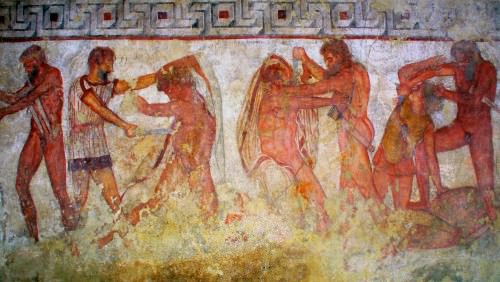
Battle Scene, Francois Tomb, Vulci
GOVERNMENT & SOCIETY
The early government of the Etruscan cities was based on a monarchy but later developed into rule by an oligarchy who supervised and dominated all public positions and a popular assembly of citizens where these existed. The only evidence of a political connection between cities is an annual meeting of the Etruscan League. This is a body we know next to nothing about except that the 12 or 15 of the most important cities sent elders to meet together, largely for religious purposes, at a sanctuary called Fanum Voltumnae whose location is unknown but was probably near Orvieto. There is also ample evidence that Etruscan cities occasionally fought each other and even displaced the populations of lesser sites, no doubt, a consequence of the competition for resources which was driven both by population increases and by a desire to control increasingly lucrative trade routes.
Etruscan society had various levels of social status from foreigners and slaves to women and male citizens. Males of certain clan groups seem to have dominated key roles in the areas of politics, religion and justice and one's membership of a clan was likely more important than even which city one came from. Women enjoyed more freedom than in most other ancient cultures, for example, being able to inherit property in their own right, even if they were still not equal to males and unable to participate in public life beyond social and religious occasions.
ETRUSCAN RELIGION
The religion of the Etruscans was polytheistic with gods for all those important places, objects, ideas, and events, which were thought to affect or control everyday life. At the head of the pantheon was Tin, although like most such figures he was probably not thought to concern himself much with mundane human affairs. For that, there were all sorts of other gods such as Thanur, the goddess of birth; Aita, god of the Underworld; and Usil, the Sun god. The national Etruscan god seems to have been Veltha (aka Veltune or Voltumna) who was closely associated with vegetation. Lesser figures included winged females known as Vanth, who seem to be messengers of death, and heroes, amongst them Hercules, who was, along with many other Greek gods and heroes, adopted, renamed and tweaked by the Etruscans to sit alongside their own deities.
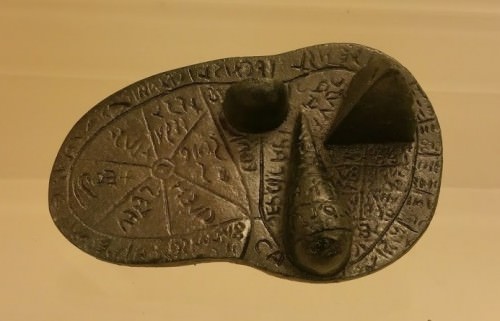
Etruscan Model Liver For Divination
The two main features of the religion were augury (reading omens from birds and weather phenomena like lightning strikes) and haruspicy (examining the entrails of sacrificed animals to divine future events, especially the liver). That the Etruscans were particularly pious and preoccupied with destiny, fate and how to affect it positively was noted by ancient authors such as Livy, who famously described them as "a nation devoted beyond all others to religious rites" (Haynes, 268). Priests would consult a body of (now lost) religious texts called the Etrusca disciplina. The texts were based on knowledge given to the Etruscans by two divinities: the wise infant Tages, grandson of Tin, who miraculously appeared from a field in Tarquinia while it was being ploughed, and the nymph Vegoia (Vecui). The Etrusca disciplina dictated when certain ceremonies should be performed and revealed the meaning of signs and omens.
Such ceremonies as animal sacrifices, the pouring of blood into the ground, and music and dancing usually occurred outside temples built in honour of particular gods. Ordinary folk would leave offerings at these temple sites to thank the gods for a service done or in the hope of receiving one in the near future. Votive offerings were, besides foodstuffs, typically in the form of inscribed pottery vessels and figurines or bronze statuettes of humans and animals. Amulets were worn, especially by children, for the same reason and to keep away evil spirits and bad luck. The presence of both precious and everyday objects in Etruscan tombs is an indicator of a belief in the afterlife which they considered a continuation of the person's life in this world, much like the ancient Egyptians. If the wall paintings in many tombs are an indicator, then the next life, at least for those occupants, started with a family reunion and rolled on to an endless round of pleasant banquets, games, dancing, and music.
ETRUSCAN ARCHITECTURE
The most ambitious architectural projects of the Etruscans were temples built in a sacred precinct where they could make offerings to their gods. Starting with dried mud-brick buildings using wooden poles and thatch roofs the temples, by c. 600 BCE, had gradually evolved into more solid and imposing structures using stone and Tuscan columns (with a base but no flutes). Each town had three main temples, as dictated by the Etrusca disciplina. Much like Greek temples in design, they differed in that usually only the front porch had columns and this extended further outwards than those designed by Greek architects. Other differences were a higher base platform, a three-room cella inside, a side entrance, and large terracotta roof decorations. These latter were first seen in the buildings of the Villanovan culture but now became much more extravagant and included life-size figure sculpture such as the striding figure of Apollo from the c. 510 BCE Portonaccio Temple at Veii.
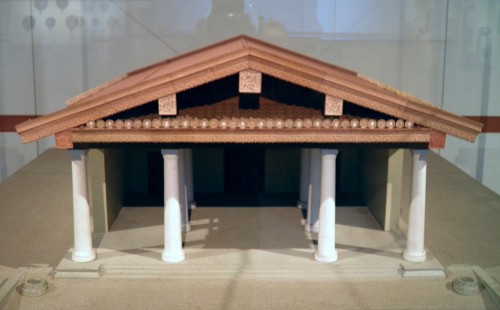
Etruscan Temple Model
Private houses from the early 6th century BCE have multiple intercommunicating rooms, sometimes with a hall and a private courtyard, all on one floor. Roofs are gabled and supported by columns. They had an atrium, an entrance hall open to the sky in the centre and with a shallow basin on the floor in the middle for collecting rainwater. Opposite was a large room, with a hearth and cistern, and side rooms including accommodation for servants.
SOME CIRCULAR TOMBS ARE HUGE & MEASURE AS MUCH AS 40 METRES IN DIAMETER.
The burial practices of the Etruscans were by no means uniform across Etruria or even over time. A general preference for cremation eventually gave way to inhumation and then back to cremation again in the Hellenistic period, but some sites were slower to change. It is the burial of members of the same family over several generations in large earth-covered tombs or in small square buildings above ground that are, in fact, the Etruscan's greatest architectural legacy. Some circular tombs measure as much as 40 metres in diameter. They have corbelled or domed ceilings and are often accessed by a stone-lined corridor. The cube-like structures are best seen in the Banditaccia necropolis of Cerveteri. Each has a single doorway entrance, and inside are stone benches on which the deceased were laid, carved altars, and sometimes stone seats were set.Built in orderly rows, the tombs indicate a greater concern with town-planning at that time.
ETRUSCAN ART
Without doubt the greatest artistic legacy of the Etruscans is their magnificent tomb wall paintings which give a unique and technicolour glimpse into their lost world. Only 2% of tombs were painted, which indicates only the elite could afford such luxury. The paintings are applied either directly to the stone wall or onto a thin base layer of plaster wash with the artists first drawing outlines using chalk or charcoal. The use of shading is minimal, but the colour shades many so that the pictures stand out vibrantly. The earliest date to the mid-6th century BCE, but topics remain consistent over the centuries with a particular love of dancing, music, hunting, sports, processions, and dining scenes. Sometimes there are also historical scenes such as the battles depicted in the Francois Tomb at Vulci. The paintings give us not only an idea of Etruscan daily life, eating habits, and clothing but also reveal social attitudes, notably to slaves, foreigners, and women. For example, the presence of married women at banquets and drinking parties (indicated by accompanying inscriptions) shows that they enjoyed a more equal social status with their husbands than seen in other ancient cultures of the period.
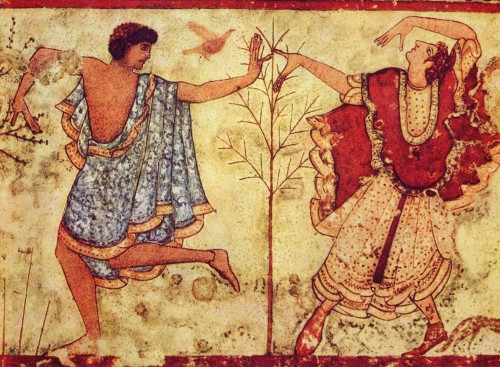
Dancers, Tomb of the Triclinium, Tarquinia
Pottery was another area of expertise. Bucchero is the indigenous pottery of Etruria and has a distinctive, almost black glossy finish. Produced from the early 7th century BCE, the style often imitated embossed bronze vessels. Popular shapes include bowls, jugs, cups, utensils, and anthropomorphic vessels. Bucchero wares were commonly placed in tombs and were exported widely throughout Europe and the Mediterranean. Another later specialisation was the production of terracotta funerary urns which had a half-life-size figure of the deceased on the lid sculpted in the round. These were painted, and although sometimes a little idealised, they, nevertheless, present a realistic portraiture. The sides of these square urns are often decorated with relief sculpture showing scenes from mythology.
Bronze work had been another Etruscan speciality dating back to the Villanovan period. All manner of daily items were made in the material, but the artist's hand is best seen in small statuettes and, particularly, bronze mirrors which were decorated with engraved scenes, again, usually from mythology. Finally, large-scale metal sculpture was produced of exceptional quality. Very few examples have survived, but those that do, notably the Chimera of Arezzo, are testimony to the imagination and skill of the Etruscan artist.
ETRUSCAN LEGACY
The Romans not only grabbed what lands and treasures they could from their neighbours but also stole quite a few ideas from the Etruscans. The Romans adopted the Etruscan practice of divination (itself an adaptation of Near Eastern practices) along with other features of Etruscan religion such as rituals for establishing new towns and dividing territories, something they would receive ample practice opportunities for as they expanded their empire. Also, Etruscan soothsayers and diviners became a staple member of elite households and army units, acknowledged as they were as the Mediterranean's experts in such matters.
The Tuscan column, arched gate, private villa with atrium, tombs with niches for multiple funerary urns, and large-scale temples on impressive raised stepped platforms are all Etruscan architectural features the Romans would adopt and adapt.Other cultural influences include the victory procession which would become the Roman triumph and the Etruscan robe in white, purple or with a red border, which would become the Roman toga. Finally, in language, the Etruscans passed on many words to their successors in Italy, and through their alphabet, itself adapted from Greek, they would influence northern European languages with the creation of the Runic script.
Roman Literature › Antique Origins
Definition and Origins
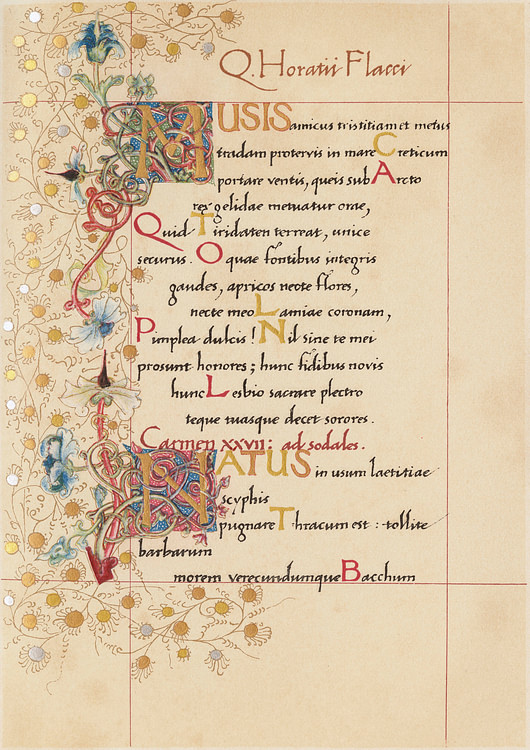
The Roman Empire and its predecessor the Roman Republic produced an abundance of celebrated literature ; poetry, comedies, dramas, histories, and philosophical tracts; the Romans avoided tragedies. Much of it survives to this day. However, Roman literature cannot stand alone. They owe a debt to their neighbor, the Greeks (more specifically Athens ). Most educated Romans were well aware of their own literary inferiority, and because of this Roman writers could easily copy Greekclassical themes, even going so far as to translate many of the notable Greek works into Latin. However, to many Romans, this exercise would have been needless, for a number of highly educated citizens could speak and read both Greek and Latin.Many young, upper-class Romans even continued their education in Athens. Although the link to Greek Hellenism would remain for years to come, the Romans would soon develop a rich literature of their own.
GREEK INFLUENCE
ROMAN LITERATURE OWES A DEBT TO THE GREEKS, MORE SPECIFICALLY ATHENS.
This indebtedness to Greece was even recognized by the writers themselves. Horace, one of the poets of the Golden Age of Roman literature wrote that Greece introduced the arts "into a backward Latium." Historian Nigel Rodgers in his Roman Empire wrote that Greek authors originated many philosophical and political concepts that influenced such Romans as Cicero, Seneca, Boethius, Catullus, and Virgil - "a Greek and Roman synthesis" (258). He added that Rome could not and did not deny that Greece was more refined and superior in both intellectual and cultural pursuits from technology and philosophy to poetry and sculpture. In reality, Rome could hardly deny a closeness to Greece since Greek cities had existed on both the lower peninsula and Sicily for decades.
COMIC PLAYWRIGHTS
According to Rodgers, there was little in the way of Roman literature before the Punic Wars against Carthage (264 – 146 BCE). It was during this time that Rome became involved in the Macedonian Wars, eventually absorbing the Greek city -states. Roman literature began near the end of the 3rd century BCE with the emergence of such comic playwrights as Plautus, Terence, and Ennius. Quite often their plays would be performed during one of the city's many festivals where the audience was mostly male.
The first of the three was Plautus (254 – 184 BCE). Of his more than 130 plays, only 20 complete works survived. According to ancient sources, he was born in Umbria and began his career as a stage carpenter. He did not begin to write anything until middle age, adapting Greek comedies into Latin. He used the usual jokes, puns, and songs (duets and arias) which quenched the Roman desire for slapstick. Although he did not write in Greek, all of his characters had Greek names and resided in Greek cities. Two of his more notable works are Aulularia ( The Pot of Gold ) and Captivi ( The Prisoners ).

Plautus
Publius Terentius Afer, better known as Terence (195 – 159 BCE), and Ennius (239 – 169 BCE) were Plautus' contemporaries.Terence arrived in Rome as a slave from North Africa, eventually gaining both his freedom and an education. Many of his plays, such as the comedy Eunuchus ( The Eunuch ), did not appeal to many of the unsophisticated Romans; he was criticized by his contemporaries for "cannibalizing" Greek plays.
Ennius, however, was more highly touted than either Plautius or Terence and is considered to be the "father of Latin poetry."Born in Calabria in southern Italy ( Magna Graecia ), he served in the Roman army in Sardinia, arriving in Rome with fellow writer Cato the Elder around 204 BCE, eventually obtaining the much-desired Roman citizenship. Even though he claimed to be the reincarnation of Homer, only fragments of his works have survived. Rodgers notes that he demonstrated how Latin poetry had achieved greatness while still emulating Greek forms. His Annals was a history of Rome from the mythical Trojan hero Aeneas through his own day. Unfortunately, he died in poverty.
GOLDEN AGE OF ROMAN POETRY
As foretold by Ennius, Latin literature would soon truly come into its own. The Golden Age of Roman poetry (c. 70 BCE – 14 CE) produced such memorable writers as Virgil, Horace, Catullus, Propertius, Tibullus, and Ovid. According to Rodgers, Virgil, Horace, and the exiled Ovid created a classical style of writing comparable to many of the great Greek authors.
One of these distinguished poets was Publius Vergilius Maro or Virgil (70 – 19 BCE). Unlike many of the poets who followed him, Virgil provided his audience with a more romanticized picture of Rome. Hailing from Cisalpine Gaul and a family of modest farmers, many of Virgil's themes demonstrate his love of the rural life. His Eclogues, written around 37 BCE, spoke of the loves and lives of shepherds, while his Georgics, written around 29 BCE, praised Roman country life: plowing, growing trees, tending cattle, and even keeping bees. However, his most memorable work is the Aeneid, an epic telling of the journeys of Aeneas after the fall of Troy through the founding of Rome by Romulus and Remus to the age of Augustus. As Aeneas was the ideal model for the Roman way of life, Augustus believed the poem demonstrated a fulfillment of Rome's destiny.

Portrait of Virgil
Quintus Horatius Flaccus, more commonly known as Horace (65 BCE – 8 BCE), was the son of a freedman. Although he fought on the wrong side at the Battle of Philippi (against Augustus), he endeared himself to the emperor partially because of his poetry but also due to his friendship with Virgil. In keeping with his Epicurean philosophy, Horace's poems demonstrated a joy for life and a love of nature. Among his many works are Satires, which was a criticism of the vice that was rampant in Rome, Epodes, inspired by the Greek author Archilochus, and Odes, a celebration of life in Rome during the age of Augustus.In all of his works, Horace always demonstrated a deep respect and admiration of the Greeks and believed Rome had to acknowledge the Greek superiority in all intellectual and cultural fields.
This new age under the reign of Augustus also produced many young poets who reacted differently to the changes in Roman politics and society. The leader of these emerging poets, Gaius Valerius Catullus (84 BCE – 54 BCE) is considered one of the greatest of all Roman lyric poets. Avoiding any personal involvement in politics, he looked to his neighbors to the east, such Greek authors as Sappho and Callimachus, for inspiration. According to historian Rodgers, his poetry mingled both passion and urbanity with an awareness of life's impermanence and he "raised colloquial Latin to new heights" (386). Similarly, historian Norman Cantor in his Antiquity said that Catullus recognized the mortality of man and exposed a different side of Roman life. His poems revealed the existence of pessimism, individualism, and deep feelings of self-indulgence within Roman society:
Furius, you who have neither a slave, nor a money-box, nor a bug, nor a spider, nor a fire, but who have a father and a stepmother too, whose teeth can chew even a flintstone, you lead a merry life with your father and that dry stick, your father's wife. (Catullus, Poem 23)
Other poets were inspired by long lost loves. The first of these lovelorn poets was Sextus Propertius (54 – 16 BCE), the son of an equestrian who unlike his fellow poets received legal training but rejected any career in politics. His most famous book of poems was Elegies. A friend of both Ovid and Virgil, he even received a home from the patron of arts Maecenas on the Esquiline Hill; however, unlike some of his contemporaries, he refused to write an epic about emperor Augustus. Like Propertius, Albius Tibullus (50 – 19 BCE), another son of an equestrian family, wrote about a lost love, Delia, and, like Virgil, he idealized the country life.
Probably the most famous or infamous poet of the era is Publius Ovidius Naro or Ovid (42 BCE – 18 CE). After Ovid, Roman poetry would take a brief hiatus. Rodgers wrote that with Ovid Latin poetry had finally attained an "elegance and lyricism" to rival that of any Greek. To Ovid love was the only "game worth playing." His Amores, published in 22 BCE, told in a very lighthearted style about the misadventures of a young man and his love for an unobtainable young girl. His Heroides was a series of 15 letters supposedly written by Greek and Roman mythological female figures such as Penelope and Dido to their lovers who had either mistreated or abandoned them. His Ars Amatoria mirrored Horace's Ars Poetica. However, his most famous work is the 15 books of mythology Metamorphoses, an epic poem that spoke not only of humanity's interaction with the gods but also of heroes and heroines. Unfortunately, Augustus did not look upon his poetry with admiration and exiled him.Although not appreciated during his lifetime, his works of poetry have influenced many of the great authors throughout history including Chaucer, Milton, Dante, Shakespeare, and Goethe.
SILVER AGE OF ROMAN POETRY
Two famous Roman poets linked to what has been called the Silver Age of Roman poetry are Marcus Annaeus Lucanus, better known as Lucan (39 – 65 CE), and Publius Papinius Statius (45 – 96 CE). Lucan, born in Spain, was the nephew of Seneca, the advisor of Emperor Nero. He even studied Stoic philosophy in Athens; however, his suspected involvement in the Piso conspiracy would cost him his life. Pharsalia, his most famous work, dealt with the Roman civil war of the 1st century BCE. His lesser known contemporary Statius wrote the twelve books of Thebaid concerning Oedipus ’s curse on Thebes.
ROMAN PROSE
While there was an abundance of poets in Rome, there were also many outstanding writers of prose. The city was alive with orators who took to the stage in the Roman Forum to voice their views to the masses. It was a platform as well for lawyers who wished to plead for their clients. One of the more memorable was Marcus Tullius Cicero (106 – 43 BCE), not only a brilliant statesman and author but also an orator who, besides his 911 letters, wrote on subjects ranging from art to education. In a series of caustic letters, he spoke out against the corrupt ex-governor of Sicily Verres forcing him into retirement, though the ex-governor would later be set free by Caesar. He wrote political essays such as De re publica ( On the State ) and De legibus ( On the Laws ) as well as five books in Latin on ancient philosophy – De finibus bonorum et malorum. His Epistulae ad familiares ( Letters to family and friends ) act as vivid historical and cultural documents of the period and give an insight into the inner workings of late Republic. Unfortunately, he had spoken out against Julius Caesar, something that angered the dictator's heir Octavian (Augustus). Having been exiled once, Cicero could not save himself and was executed before he could escape Rome.

Cicero
Lucius Annaeus Seneca (4 BCE – 65 CE) was a student of Stoic philosophy and tutor to Emperor Nero. Not only an essayist, he wrote nine plays based on such Greek legends as Oedipus, Heracles, and Medea. He also authored 124 essays on subjects ranging from vegetarianism to the humane treatment of slaves. After being implicated in the Piso conspiracy, he was forced to commit suicide by Nero.
Pliny the Elder (23 – 79 CE) or Gaius Plinius Secundus was a Roman administrator who wrote on the Germanic wars and whose Natural History ( Naturalis Historia ) contained information on the known universe as well as tracts on animals, trees, and plants, all in 37 volumes. Volume III, for example, describes the geography of Italy and the topography of Rome:
If one were further to take into account the height of the buildings, a very fair estimate would be formed, that would bring us to admit that there has been no city in the whole world that could be compared to Rome in magnitude. (Pliny the Elder, Natural History, Book III, 67)
Observing the eruption of Mt. Vesuvius in 79 CE, Pliny the Elder died after inhaling fumes. His nephew Pliny the Younger (61 – c. 112 CE) had a successful career as both a senator and consul under Emperor Trajan. He is most noted for his long series of letters on a variety of topics to the emperor.
There were also a number of Roman novelists: Petronius, Apuleius, Martial, and Juvenal. Petronius or Gaius Petronius Arbiter (c. 27 – 66 CE) served as both a consul and governor of Bithynia. His most famous work and the only one to survive is the Satyricon, a work considered witty but amoral and hedonistic. Unfortunately, like several of his contemporaries, he was implicated in the Piso conspiracy during Nero's reign and was forced to commit suicide in 66 CE.
Lucius Apuleius (c. 124 – c. 170) from North Africa wrote a number of excellent works including the amoral The Golden Asswhich is the only complete Roman novel to survive. One of the eleven separate books included in the novel spoke of the adventures of a young man named Lucius who is transformed into an ass. His other works include Apologia, Florida, and De Deo Socratis.
Marcus Valerius Martialis (c. 40 – c. 104 CE), better know as Martial, although originally from Spain, spent most of his life in Rome. A close friend of Emperor Domitian, he wrote epigrams on a variety of subjects, some of which might be called pornography:
Why don't I kiss you, Philaenis? You're bald. Why don't I kiss you, Philaenis? You're red-headed. Why don't I kiss you, Philaenis? You're one-eyed. Whoever kisses all that, Philaenis, sucks. (Martial, Epigram 2.33, in Williams, 128)
Decius Junius Juvenalis or Juvenal (c. 60 – c. 130 CE) is considered the greatest of the Roman satirists. Unfortunately, he ran afoul of Emperor Domitian who believed he had been portrayed negatively in the writer's Satires and may have been exiled to Egypt ; his place of death is unknown.
LATER ROMAN LITERATURE
A disseminação do cristianismo deu origem a um novo tipo de literatura do século IV dC, com clérigos escrevendo sobre a moralidade cristã em nítido contraste com as obras amorais e muitas vezes sexualmente explícitas dos séculos anteriores. Um dos principais clérigos do século IV foi Santo Ambrósio (c. 340 - 397 dC). Ambrósio era filho do prefeito pretoriano da Gália e educado na tradição grega clássica. Ele serviu como bispo de Roma e Milão, bem como governador de Aemilia-Liguria, apesar de muitas vezes desafiar o imperador Teodósio. Entre seus escritos estão De officiis ministrorum, uma discussão de moralidade e disciplina eclesial, bem como De obitu Valentiniani e De obitu Theodocii que estabeleceu o conceito de que um imperador cristão era filho da igreja.
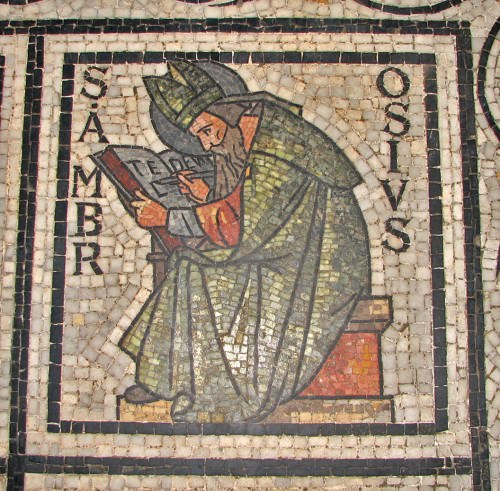
St. Ambrose
Decimus Magnus Ausonius (310 – 395 CE) came from Bordeaux and served as the tutor for the future emperor Gratian; he was a noted grammarian and rhetorician. He was less concerned with Christian values and wrote on a variety of subjects. His more noted works are Praefatiunculae ( Prefaces ) and Eclogarum Liber (Eclogues), verses on astronomy and astrology. Lastly, one cannot forget the writings of St. Augustine (354-430 CE). He is most famous for his De civitate Dei ( The City of God) which he wrote near the end of Western Roman Empire at the time of the invasion of 410 CE and his Confessions.
While Ambrosius, Augustine, and Ausonius represented the emergence of Christian writers, one pagan author also appeared on the scene, Claudius Claudianus (370 – 404 CE). Claudianus, a native of Alexandria, was the court poet under Emperor Honorius. He wrote panegyrics for Honorius and Stilicho, the Roman general. Influenced by earlier poets, both Roman and Greek, he is considered the last important poet of the classical tradition.
HISTORIANS
Besides the writers of poetry and prose, there were the historians: Sallust, Tacitus, Livy, and Suetonius. Unfortunately, much of early Roman history is based on myth, and some historians sadly accepted it as fact. However, real or not, it gave the Romans a sense of identity. The first historian of note was Gaius Sallustius Crispus or Sallust (c. 86 – 35 BCE), a former senator expelled for immorality. So inspired by the Greek historian Thucydides, he turned to writing history. An enemy of Cicero, he sided with dictator-for-life Julius Caesar who helped him fight charges of malpractice while governor of Africa. His most famous works include Bellum Catilinae, which dealt with the Catiline conspiracy, Bellum Iugurthinum, um livro preocupado com a guerra romana contra o rei da Numídia, Jugurta, e Histórias, que permanece apenas em fragmentos.
Lívio (59 aC - 17 dC) escreveu uma história detalhada de Roma em 142 livros, no entanto, infelizmente apenas 35 sobrevivem. Embora ele aceitasse muitos mitos como fatos, sua história demonstrou sua crença no destino de Roma.
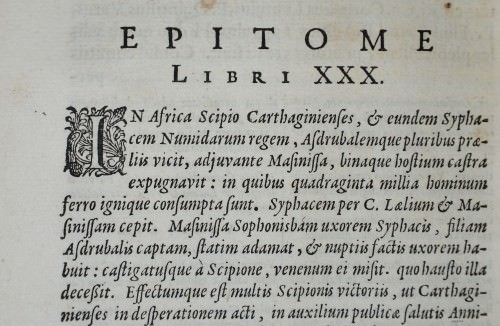
História romana de Livy, 1664
As obras de Cornelius Tacitus (58 - 120 EC) incluem De vita Iulii Agricolae, que fala do tempo de seu sogro como governador da Grã-Bretanha ; Germania, lidando com as guerras contra as tribos da Alemanha; e os anais e histórias fragmentadas.
Por fim, Gaius Suetonius Tranquillus (c. 69 - c. 130 dC) deve ser mencionado. Seu De viris illustribus incluía pequenas biografias de homens de letras romanos; poetas, gramáticos, oradores e filósofos. Seu De vita Caesarum ( Os Doze Césares) falou dos "caesars" romanos de Júlio César a Domiciano. Usando histórias anteriores como fontes, suas obras são consideradas interessantes, mas não totalmente confiáveis. Eles estão mais preocupados com os hábitos pessoais de um imperador do que com suas realizações políticas.
Infelizmente, Roma não produziu muitos filósofos como a Grécia; no entanto, há dois que devem, pelo menos, ser mencionados. Marco Aurélio não era apenas um excelente imperador, mas também um filósofo estóico; suas Meditaçõesforam escritas em grego. Finalmente, T. Lucretius Carus (99 - 55 aC) escreveu Sobre a Natureza do Universo, uma doutrina epicurista que dizia que o mundo era mecanicista, operando sem intervenção divina e verdadeira felicidade existindo da completa retirada da vida pública.
LEGACY
Desde a sua infância, a literatura romana emprestou pesadamente dos gregos. No entanto, eles foram capazes de sacudir os grilhões e criar uma literatura vibrante própria; poesia, prosa e história. Os autores romanos influenciaram inúmeros outros nas décadas e séculos que se seguiram - Dante, Shakespeare, Milton e muitos outros. Não se pode entrar nem numa biblioteca nem numa livraria sem ver poesia romana e prosa nas estantes; Cícero, Tácito, Suetônio, assim como Virgílio e Horácio. A literatura ocidental deve uma dívida de gratidão aos romanos pelo que deram ao mundo.
LICENSE:
Article based on information obtained from these sources:with permission from the Website Ancient History Encyclopedia
Content is available under License Creative Commons: Attribution-NonCommercial-ShareAlike 3.0 Unported. CC-BY-NC-SA License